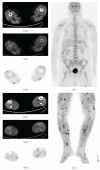FDG-PET or PET/CT in Fever of Unknown Origin: The Diagnostic Role of Underlying Primary Disease
- PMID: 21490728
- PMCID: PMC3065735
- DOI: 10.1155/2011/318051
FDG-PET or PET/CT in Fever of Unknown Origin: The Diagnostic Role of Underlying Primary Disease
Abstract
Fever of unknown origin (FUO) is generally defined as a fever greater than 38.3°C on several occasions during a period longer than 3 weeks for which the etiology behind cannot be diagnosed at the end of at least 1 week hospital stay. Conventional diagnostic methods are still not adequate to reveal underlying reason in approximately 50% of patients with FUO. In patients with certain diagnosis, three major categories are infections, malignancies, and noninfectious inflammatory diseases. Fluoro-18-fluoro-2-deoxy-D-glucose (FDG) is a structural analog of 2-deoxyglucose and accumulates in malignant tissues but also at sites of infection and inflammation. For this reason, FDG PET or PET/CT has great advantage in understanding of underlying pathology in assessment of FUO. However, till today, there are limited studies about the role of FDG PET or PET/CT in evaluation of FUO. In this paper, the impact of FDG PET or PET/CT in the diagnostic work-up of FUO is described by data obtained from literature review.
Figures




Similar articles
-
The diagnostic role of 18-fluorodeoxyglucocose-positron emission tomography/computed tomography in occult bacteremia searching underlying primary disease.Ann Indian Acad Neurol. 2012 Oct;15(4):336-8. doi: 10.4103/0972-2327.104353. Ann Indian Acad Neurol. 2012. PMID: 23349610 Free PMC article.
-
18F-FDG PET and PET/CT in fever of unknown origin.J Nucl Med. 2007 Jan;48(1):35-45. J Nucl Med. 2007. PMID: 17204697
-
The Diagnostic Role of FDG PET/CT in Patients with Fever of Unknown Origin.Mol Imaging Radionucl Ther. 2011 Apr;20(1):19-25. doi: 10.4274/MIRT.20.04. Epub 2011 Apr 1. Mol Imaging Radionucl Ther. 2011. PMID: 23487158 Free PMC article.
-
Fever of Unknown Origin: the Value of FDG-PET/CT.Semin Nucl Med. 2018 Mar;48(2):100-107. doi: 10.1053/j.semnuclmed.2017.11.004. Epub 2017 Dec 8. Semin Nucl Med. 2018. PMID: 29452615 Review.
-
FDG-PET in fever of unknown origin.Semin Nucl Med. 2013 Sep;43(5):333-9. doi: 10.1053/j.semnuclmed.2013.04.005. Semin Nucl Med. 2013. PMID: 23905615 Review.
Cited by
-
The diagnostic value of 18F-FDG PET/CT in identifying the causes of fever of unknown origin.Clin Med (Lond). 2020 Sep;20(5):449-453. doi: 10.7861/clinmed.2020-0268. Clin Med (Lond). 2020. PMID: 32934036 Free PMC article.
-
Current Applications for Nuclear Medicine Imaging in Pulmonary Disease.Curr Pulmonol Rep. 2020;9(3):82-95. doi: 10.1007/s13665-020-00251-1. Epub 2020 Jul 22. Curr Pulmonol Rep. 2020. PMID: 32837866 Free PMC article. Review.
-
Differentiating Disease Flare From Infection: A Common Problem in Rheumatology. Do 18F-FDG PET/CT Scans and Novel Biomarkers Hold The Answer?Curr Rheumatol Rep. 2018 Sep 17;20(11):70. doi: 10.1007/s11926-018-0779-4. Curr Rheumatol Rep. 2018. PMID: 30225546 Free PMC article. Review.
-
"To be or not to be" for PET in rheumatology. A marriage of love or of convenience?Reumatologia. 2017;55(1):1-3. doi: 10.5114/reum.2017.66679. Epub 2017 Mar 22. Reumatologia. 2017. PMID: 28386135 Free PMC article. No abstract available.
-
Imaging modalities in the management of aortitis.Indian J Thorac Cardiovasc Surg. 2019 Jun;35(Suppl 2):67-71. doi: 10.1007/s12055-018-0710-7. Epub 2018 Aug 10. Indian J Thorac Cardiovasc Surg. 2019. PMID: 33061068 Free PMC article.
References
-
- Petersdorf RG, Beeson PB. Fever of unexplained origin: report on 100 cases. Medicine. 1961;40:1–30. - PubMed
-
- Gaeta GB, Fusco FM, Nardiello S. Fever of unknown origin: a systematic review of the literature for 1995–2004. Nuclear Medicine Communications. 2006;27(3):205–211. - PubMed
-
- Mourad O, Palda V, Detsky AS. A comprehensive evidence-based approach to fever of unknown origin. Archives of Internal Medicine. 2003;163(5):545–551. - PubMed
-
- Tabak F, Mert A, Celik AD, et al. Fever of unknown origin in Turkey. Infection. 2003;31(6):417–420. - PubMed
-
- Otsuka H, Morita N, Yamashita K, Nishitani H. FDG-PET/CT for diagnosis and follow-up of vasculitis. Journal of Medical Investigation. 2007;54(3-4):345–349. - PubMed
LinkOut - more resources
Full Text Sources

